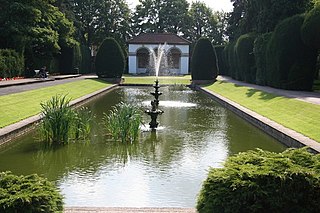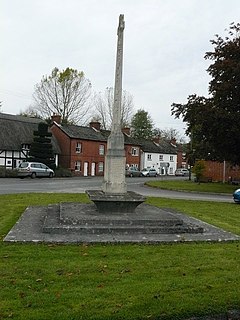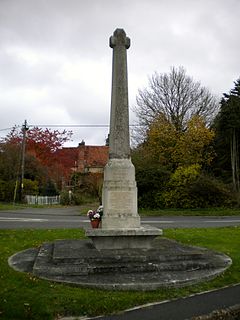
Rochdale Cenotaph is a First World War memorial on the Esplanade in Rochdale, Greater Manchester, in the north west of England. Designed by Sir Edwin Lutyens, it is one of seven memorials in England based on his Cenotaph in London and one of his more ambitious designs. The memorial was unveiled in 1922 and consists of a raised platform bearing Lutyens' characteristic Stone of Remembrance next to a 10-metre (33 ft) pylon topped by an effigy of a recumbent soldier. A set of painted stone flags surrounds the pylon.

The South African War Memorial is a First World War memorial in Richmond Cemetery in the London Borough of Richmond upon Thames. Designed by architect Sir Edwin Lutyens, the memorial is in the form of a cenotaph, similar to that on Whitehall, also by Lutyens. It was commissioned by the South African Hospital and Comforts Fund Committee to commemorate the 39 South African soldiers who died of their wounds at a military hospital in Richmond Park during the First World War. The memorial was unveiled by General Jan Smuts in 1921 and was the focus of pilgrimages from South Africa through the 1920s and 1930s, after which it was largely forgotten until the 1980s when the Commonwealth War Graves Commission took responsibility for its maintenance. It has been a grade II listed building since 2012.

The Devon County War Memorial is a First World War memorial, designed by Sir Edwin Lutyens and situated on Cathedral Green in Exeter, the county town of Devon, in the south west of England. It is one of fifteen War Crosses designed by Lutyens with similar characteristics, and one of two to serve as a civic memorial in a city. The first proposal for the county's war memorial was to complete the construction of a cloister at Exeter Cathedral to be dedicated to Devon's war dead, but this scheme was abandoned due to lack of funds. After considering multiple proposals, the Devon County War Memorial Committee commissioned Lutyens to design a War Cross instead. The committee chose to site the memorial on the green of Exeter Cathedral after scouting several locations. A war memorial for Exeter itself was being considered concurrently, but the committees for the two projects failed to work together, resulting in two separate memorials—the county memorial by the cathedral and Exeter City War Memorial in Northernhay Gardens.

Spalding War Memorial is a First World War memorial in the gardens of Ayscoughfee Hall in Spalding, Lincolnshire, in eastern England. It was designed by the architect Sir Edwin Lutyens. The proposal for a memorial to Spalding's war dead originated in January 1918 with Barbara McLaren, whose husband and the town's Member of Parliament, Francis McLaren, was killed in a flying accident during the war. She engaged Lutyens via a family connection and the architect produced a plan for a grand memorial cloister surrounding a circular pond, in the middle of which would be a cross. The memorial was to be built in the formal gardens of Ayscoughfee Hall, which was owned by the local district council. When McLaren approached the council with her proposal, it generated considerable debate within the community and several alternative schemes were suggested. After a public meeting and a vote in 1919, a reduced-scale version of McLaren's proposal emerged as the preferred option, in conjunction with a clock on the town's corn exchange building.

Northampton War Memorial, officially the Town and County War Memorial, is a First World War memorial on Wood Hill in the centre of Northampton, the county town of Northamptonshire, in central England. Designed by architect Sir Edwin Lutyens, it is a Stone of Remembrance flanked by twin obelisks draped with painted stone flags standing in a small garden in what was once part of the churchyard of All Saints' Church.

The York City War Memorial is a First World War memorial designed by Sir Edwin Lutyens and located in York in the north of England. Proposals for commemorating York's war dead originated in 1919 but proved controversial. Initial discussions focused on whether a memorial should be a monument or should take on some utilitarian purpose. Several functional proposals were examined until a public meeting in January 1920 opted for a monument. The city engineer produced a cost estimate and the war memorial committee engaged Lutyens, who had recently been commissioned by the North Eastern Railway (NER) to design their own war memorial, also to be sited in York.

Busbridge War Memorial is a First World War memorial in the churchyard of St John's Church in village of Busbridge in Surrey, south-eastern England. Designed by Sir Edwin Lutyens, it is Grade II* listed.

The British Thomson-Houston Company War Memorial is a First World War memorial in Rugby, Warwickshire, in the West Midlands of England. It was erected by the British Thomson-Houston Company in memory of the firm's employees who left to fight in the First World War and were killed in service. Designed by Sir Edwin Lutyens, it was unveiled in 1921 and is now a grade II* listed building.

The Welch Regiment War Memorial, also known as the Maindy Monument is a First World War memorial at Maindy Barracks in the Cathays area of Cardiff in Wales. The memorial was designed by Sir Edwin Lutyens and follows his design for the Cenotaph on Whitehall in London. Unveiled in 1924, it commemorates men of the Welch Regiment who fell in the First World War, and is today a grade II listed building.

Hove War Memorial is a First World War memorial on Grand Avenue in Hove, East Sussex, on the south-east coast of England. The memorial was designed by Sir Edwin Lutyens with sculpture by Sir George Frampton and closely resembles Fordham War Memorial in Cambridgeshire, which was also a collaboration between Lutyens and Frampton. It was unveiled in 1921 and is today a grade II listed building.

Fordham War Memorial is a First World War memorial in the village of Fordham in Cambridgeshire in eastern England. The memorial was designed by Sir Edwin Lutyens with sculpture by Sir George Frampton and closely resembles Hove War Memorial in East Sussex, which was also a collaboration between Lutyens and Frampton. It was unveiled in 1921 and is today a grade II listed building.

Lower Swell War Memorial is a First World War memorial in the centre of the village of Lower Swell in Gloucestershire in south-western England. The memorial, designed by Sir Edwin Lutyens, was unveiled in 1921 and is today a grade II listed building.

Abinger Common War Memorial is a First World War memorial in the village of Abinger Common in Surrey, south-eastern England. The memorial was destroyed by a German bomb during the Second World War and rebuilt in the late 1940s. One of 15 war crosses by Sir Edwin Lutyens, it is a grade II listed building.

Hartburn War Memorial is a First World War Memorial in the village of Hartburn, Northumberland, in the north-east of England. The memorial, designed by Sir Edwin Lutyens, was unveiled in 1921 and is today a grade II listed building.

King's Somborne War Memorial is a First World War memorial in the village of King's Somborne in Hampshire in southern England. The memorial was designed by Sir Edwin Lutyens and unveiled in 1921; it is a grade II listed building.

Stockbridge War Memorial is a First World War memorial in the town of Stockbridge in Hampshire in southern England. The memorial was designed by Sir Edwin Lutyens and unveiled in 1921; it is a grade II listed building.

Muncaster War Memorial is a First World War memorial in the parish of Muncaster on the west coast of Cumbria in the far north-west of England. The memorial is one of fifteen War Crosses designed by Sir Edwin Lutyens; it was unveiled in 1922 and is now a grade II listed building.

Wargrave War Memorial is First World War memorial in the village of Wargrave in Berkshire, south-eastern England. Designed by Sir Edwin Lutyens, the memorial was unveiled in 1922 and is today a grade II listed building.

Sandhurst War Memorial is a First World War memorial in the village of Sandhurst in Kent, south-eastern England, close to the border with East Sussex. The memorial is one of fifteen War Crosses by Sir Edwin Lutyens and arguably the one with the most elaborate setting. It was unveiled in 1923 and is today a grade II listed building.

Rolvenden War Memorial is a First World War memorial in the village of Rolvenden, Kent, in south-eastern England. Designed by Sir Edwin Lutyens, the memorial was unveiled in 1922 and is today a grade II listed building.




















